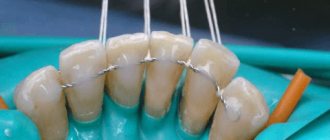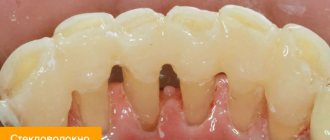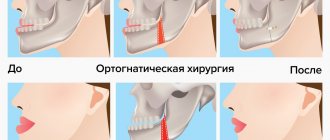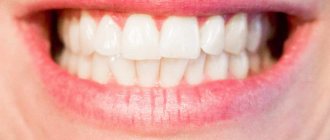Osteosynthesis is a surgical treatment for a jaw fracture , which involves the use of special, most often metal, plates to fix the fragments. The operation is performed in cases where connecting bone elements with a splint is difficult or impossible, or it is difficult to fix them in the correct position. In modern practice, several methods of jaw osteosynthesis using plates are used. The choice of a specific technique depends on the severity of the injury and its nature.
Plates for jaw fracture
The use of plates after a jaw fracture is justified when a conservative treatment method either does not give the desired result (correct reposition and high-quality fusion of bone parts) or cannot be used initially (complex injury). The decision to perform an operation is made by the doctor after examining the patient (examination if treatment methods other than surgery have already been used).
The advantage of bone osteosynthesis is that when plates are installed to connect fragments, the lesion site is well supplied with blood. This ensures fairly rapid fusion - in just a few weeks - while restoring the bone itself (integrity) and its anatomically correct structure.
Types of fractures and healing features
The task of a dental surgeon in the event of a patient’s jaw fracture is to restore the integrity of the broken bone along with the dentition.
Up to 70% of damage occurs in the lower jaw due to:
11
- accidents, accidents;
- blows during a fight;
- sports injuries;
- complications of serious diseases.
The collective concept of trauma combines a wide range of injuries.
Healing will be faster and more effective if symptoms are correctly recognized and time is not wasted in providing medical care.
The healing time of the jaws will differ significantly in the case of:
- direct or indirect fractures, i.e., distant from the point of impact;
- closed or open injuries, i.e. with rupture of soft tissues;
- with displacement of bone fragments or without displacement, while maintaining the anatomical location;
- a complete fracture with the advancement of a fragment with an angle, or a comminuted one (one of the most dangerous) with dispersed fragments in disarray.
An accurate assessment of the damage can be made based on the x-ray and clinical picture.
Healing times largely depend on the type of fracture and the provision of timely assistance. Soft tissue injuries, bone displacement, concussion, contusions and associated injuries increase the period of inpatient observation.
Features of jaw treatment may be associated with general diseases of the patient.
Types of jaw osteosynthesis
Osteosynthesis with a metal plate for a jaw fracture is carried out in different ways. It is divided into types according to 2 characteristics - the method of fixing the plates and the technology of the operation itself.
- According to the method of fixing the plate for a jaw fracture, osteosynthesis can be: focal, when the elements of the plate are installed so as to cross the fracture gap and adjoin it;
- extrafocal, in which the plate is fixed outside the jaw fracture gap or passes through it above the mucous membrane and skin (without touching damaged tissues).
- open is carried out with dissection of soft tissues and “opening” of the ends of bone fragments (separation of the periosteum);
The closed method provides accelerated healing, since it does not involve complications that are possible due to impaired microcirculation in soft tissues. But the lack of visual control during closed osteosynthesis of the jaw makes it difficult to properly connect the bone elements and carry out the manipulation in general. This requires a very highly qualified specialist.
The open method of installing plates for jaw fractures (with visualization of the bone) makes it possible to most accurately compare the fragments, as well as remove damaged (interposed) soft tissues or small fragments of hard tissue. The main difficulty of the operation is the risk of tissue hypoxia, which is a common cause of enchondral osteogenesis.
The latter involves the transition of callus to the stage of cartilage, which is not typical for the lower jaw. With enchondral osteogenesis, the formation of a typical (ossified) callus of the lower jaw slows down.
Modern methods also include ultrasonic osteosynthesis with plates . It is carried out using special modern technology and is less traumatic. Installing plates for fractures using ultrasound equipment reduces the likelihood of complications.
How does a fracture occur?
Human jaws have different structures. Due to these features, the symptoms of fractures and healing time will vary.
Table. Features of the structure of maxilla and mandibula:
| Upper jaw | Lower jaw |
| Narrower and lighter compared to the bottom one. Contains air sinuses. It has four processes that are part of the orbit and hard palate. It is immovably connected to the bones of the facial skull. | More massive and heavier. There are no sinuses. There are openings for nerves and blood vessels. It has two processes, with the help of which it forms a movable connection with the bones of the skull. |
|
|
The maxilla fracture occurs more easily than the mandibula. They can be broken in the following situations:
- direct or side blow to the jaw;
- with a sharp displacement of the jaws and slamming of the mouth;
- when colliding with a hard object or falling to the ground.
A specialist tells more about the causes and mechanism of the fracture in the video in this article:
Symptoms of a mandibula fracture are more severe than with a mandibular fracture. How long it takes the jaw to heal after a fracture will depend on which of them is broken. The lower one will take much longer to heal. How long a fracture of the lower jaw takes to heal depends on the nature of the damage and in what part of the bone it occurred.
Indications for osteosynthesis of the jaw with plates
The main indication for installing metal plates for osteosynthesis is the prevention of complications that cannot be effectively prevented by applying a traditional splint. In the case of osteosynthesis, an important task for the surgeon is to compare the fragments and fix them in the correct position. If successful, fusion will take up to 3–4 weeks.
Indications:
- fracture behind a row of teeth;
- inflammation that provoked injury;
- significant displacement of bone elements;
- high mobility of teeth at the fracture site;
- incorrect position of the jaws relative to each other.
Causes of damage
Many people think how hard it takes to break a jaw. In fact, even if you bite food incorrectly or close your jaws, you can injure them and, if the bone tissue is weakened, its integrity can be disrupted.
Main reasons:
- blows;
- injuries in athletes;
- falls;
- car crashes.
In some sports, only the teeth are protected from impacts. But the jaw, the bone tissue itself, is almost always defenseless. Even an unsuccessful fall can injure this bone.
Installation
Installation of plates for a jaw fracture using the open method is carried out in 4 stages:
- a soft tissue incision is made to visualize and connect the fragments;
- connecting bone fragments using a plate;
- fixation of bone elements with glue, staples, quick-hardening plastics used in modern surgery;
- suturing.
The main difficulty of open surgery is trauma. The doctor works with the area in which the nerve endings and salivary glands are located, which creates the risk of damage to them, and therefore determines high requirements for the qualifications of the specialist.
A safer and less traumatic method is ultrasonic osteosynthesis of the jaw. It not only reduces the risk of complications during fixation, but also reduces the time for fracture healing.
Rubber bands for splinting
In some cases, splinting with wire requires additional fastening with special rubber bands to fix the jaws in a closed state. The main purpose of the rubber bands is to move the teeth in the direction in which they were originally. There are many advantages of elastic material:
- The rubber bands are easy to cut and remove, which is especially important if the patient has suffered a head injury and there is a risk of complications in the form of epileptic seizures, fainting and other neurological disorders.
- With the correct tension, the elastic bands allow you to take food through a tube; a tighter fastening often leads to tube feeding.
- Damaged rubber bands can be easily replaced, while damage to the metal structure will require serious medical intervention.
The decision to install rubber bands for splinting must be made by a doctor and most often they begin to be used only when primary healing of the injured jaw has occurred. In the first stages, as a rule, more rigid fixation is required. In any case, consultation with a specialist is required, who, based on the condition of the teeth, the nature of the damage, and the general condition of the patient, will be able to determine the most suitable type of splinting. Dr. Sadov’s clinic in Moscow employs professionals who have completed internships abroad and clearly understand the specifics of dental orthopedics.
Recovery after surgery
Rehabilitation after installation of a titanium plate for a jaw fracture takes 6 months. The specific recovery time depends on how much time has passed from the moment of injury to treatment, as well as on the patient’s age, his condition, the severity of the injury, and the method of osteosynthesis.
Rules during rehabilitation:
- immediately after the manipulation, a bandage is applied for fixation; it must be worn constantly;
- it is important to exclude any movements (talking, chewing, opening and closing the mouth);
- drug rehabilitation involves taking a course of antibiotics and restoratives, the drugs are selected individually and prescribed by a doctor;
- for recovery, the patient is prescribed decongestant and anti-inflammatory physiotherapy (from day 2 - UHF, from day 4 - magnetic therapy, after 2 weeks you can start a course of electrophoresis);
- classes in LVF (therapeutic and restorative physical education) begin 3–5 weeks after removing the fixing bandage, their goal is to restore normal speech function, normalize chewing, and facial expressions.
For the entire recovery period after installation of a plate for a fracture, the patient is prescribed a diet (liquid meals, purees, strictly at room temperature, taken through a straw). Solid food is introduced into the diet gradually after the bandage is removed and chewing functions are restored.
To avoid complications, it is important to maintain good oral hygiene. You can brush your teeth only after removing the bandage and restoring mobility, so in the first weeks hygiene comes down to rinsing your mouth, which should be done up to 10 times a day (including after each meal).
Cure period
The question of how long it takes for a jaw fracture to heal does not have an exact answer. The minimum period for restoration of basic functions is 1.5 months.
There is no need to rush to remove the splint or constructive devices for restraining the bone, so as not to harm the weakened organ and not be left with displaced teeth or wide dental gaps.
Statistics reflect therapeutic treatment on average up to 60 days. Accurate forecasts are always individual. Removal of splints and fixing elements is carried out after 30-45 days.
The success and duration of treatment largely depends on the patient’s desire to overcome the illness and difficult situation.
You can enjoy your recovery both when the fixation is removed, discharged from the hospital, and when the functionality of the jaw is fully restored without pain.
How to speed up the healing time of implants
Osseointegration is a physiological process, the speed depends on the condition of the patient’s bone tissue, the implantation method, and compliance with recommendations. But to protect yourself from unwanted rejection, you need to take care of this in advance:
- choose a clinic carefully - you should contact trusted institutions based on recommendations from friends after carefully studying the site and available information;
- contact a qualified doctor - you cannot go to a private specialist who does not officially work in the clinic, you should ask him for certificates, look at photos of examples of work;
- do not refuse preliminary preparation and diagnosis - a qualified doctor will insist on this stage;
- choose high-quality implants - preference for companies that have been presenting products on the market for at least 10 years;
- find out the warranty period and service - the nuances should be clarified before the procedure;
- check compliance with sterility and safety - clinics with a good reputation should work according to the Anti-AIDS-Anti-Hepatitis program.
What determines the success of osseointegration
Several factors influence the success of engraftment:
- Proper preparation and planning.
- Patient's health status.
- Use of high-quality implants.
- Selecting an implantation method that is appropriate for the clinical situation.
- Correct calculation of the prosthesis design.
- Compliance with recommendations after implantation.
Attentive attention to each point ensures engraftment without complications.
Risks at the diagnostic and preparation stage
In order for engraftment to proceed without problems, it is important to eliminate risks at the stage of preparation for implantation:
- An examination is carried out for general somatic diseases to identify contraindications to surgery.
- The doctor diagnoses diseases of the oral cavity that are in the acute stage, paying close attention to the future site of implantation and surrounding tissues. The oral cavity is sanitized, adjacent teeth are treated, and plaque and stone are removed.
- An implant treatment plan is drawn up, and recommendations are given to the patient on the rules of preparation for the operation.
- 3D computer modeling helps to choose the shape and size of the implant. This is necessary so that the design fits the patient’s bone characteristics and does not reject it.
Patient's health status
Successful implantation is impossible in case of serious diseases that can cause implant rejection. The main contraindications for which implantation is strictly prohibited:
- malignant tumors;
- decompensated diabetes mellitus;
- blood clotting disorder;
- mental illness;
- tuberculosis;
- pathological diseases of the cardiovascular system;
- risk of heart attack or cardiac arrest;
- disruption of the immune system;
- thyroid diseases.
The patient should not hide his condition and agree to the procedure without prior diagnosis. In addition, diagnostics will help identify hidden diseases that you may not be aware of. Therefore, before the procedure, the doctor collects anamnesis and prescribes tomography, blood tests, and ECG for patients at risk.











